4th Grade : Demonstration Class (研究授業)
Class 4-1 had a demonstration class on the last day of term. The class was a continuation of their previous class on the phrase "Let's~!". This was lesson 5/5 on this topic.
First, the class started with a greeting game. As well as asking "How are you?" the students also complimented each other.
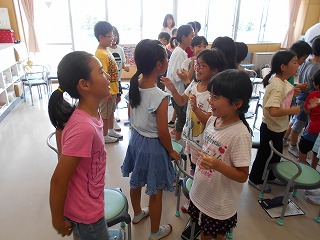 "Nice t-shirt!"
"Nice t-shirt!"
Bit by bit we are trying to extend the conversations the students can have by increasing their vocabularies.
Next, the students reviewed the English for sports and games. The students could also use some extra new vocabulary (hiking, shopping, go to a festival, etc.).
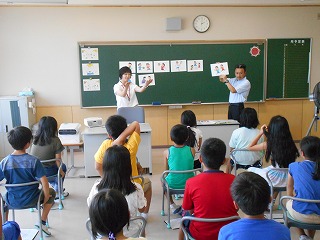 "What's this?"
"What's this?"
After that they practiced using the phrase "Let's~!". The students could answer if they wanted to play together or not.
"Let's play table tennis!"
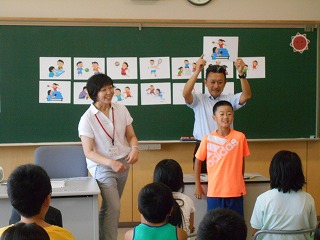 "Yes, let's!"
"Yes, let's!"
"Let's play soccer!"
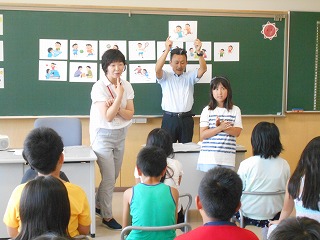 "Sorry! No, thank you."
"Sorry! No, thank you."
In the last class the students invited each other to play different games at lunch time. In this class the focus was on summer vacation. Let's invite our friends to do something together during summer vacation. The new vocabulary they studied at the start of the class was focused on summer activities (festival etc.).
First, the two teachers game a demonstration. Can you tell what activity Mr. Ota is inviting Ms. Mayumi to do?
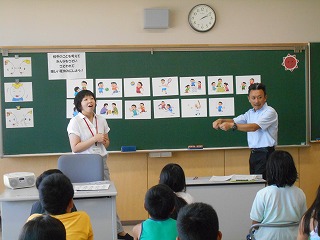 It's fishing! "Let's go fishing!"
It's fishing! "Let's go fishing!"
After the two teachers demonstration the next step was one teacher-one student demonstration.
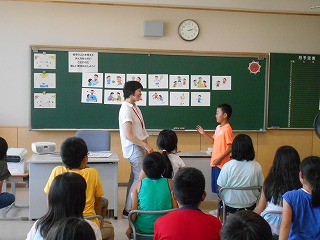 "Hello!"
"Hello!"
The last demonstration was done by two students.
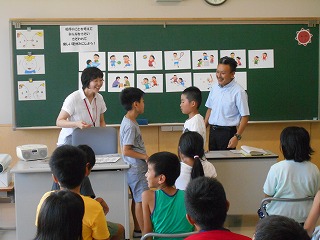 Both teachers were there to help if the students needed it.
Both teachers were there to help if the students needed it.
After the demonstrations it was time to start the activity! "Let's start!"
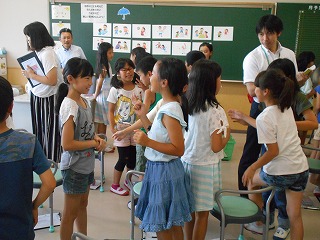 The students tried their best to invite their friends to do fun things in the summer vacation.
The students tried their best to invite their friends to do fun things in the summer vacation.
Half-way through the activity the teachers chose two students to give a demonstration and everyone had to think about the good points.
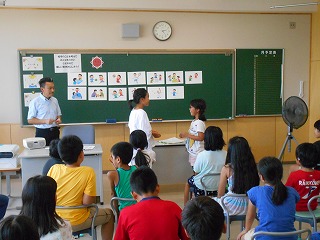 "They have good gestures!"
"They have good gestures!"
Then, everyone restarted the activity, keeping in mind the good points about the demonstration.
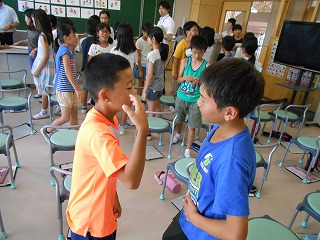 Great gestures!
Great gestures!
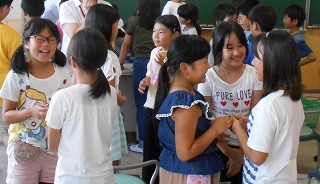 Nice smiles!
Nice smiles!
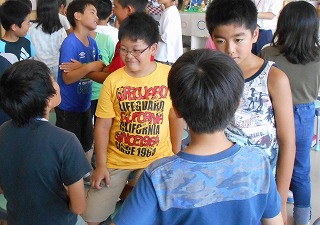 Good eye contact!
Good eye contact!
After the activity the students wrote their feedback card. Recently students have only been writing their feedback cards on the last lesson of the topic. It means there is more time for activities in other lessons.
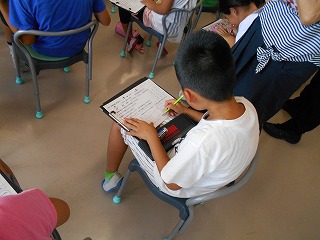 Students have to think about the whole topic.
Students have to think about the whole topic.
The teachers picked some students to announce to the class what they wrote.
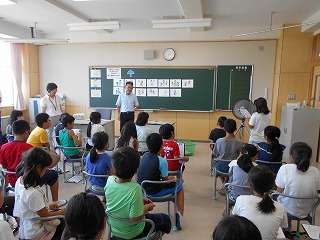 Everyone did their best!
Everyone did their best!
Well done 4th grade students and teachers!
First, the class started with a greeting game. As well as asking "How are you?" the students also complimented each other.
 "Nice t-shirt!"
"Nice t-shirt!"Bit by bit we are trying to extend the conversations the students can have by increasing their vocabularies.
Next, the students reviewed the English for sports and games. The students could also use some extra new vocabulary (hiking, shopping, go to a festival, etc.).
 "What's this?"
"What's this?"After that they practiced using the phrase "Let's~!". The students could answer if they wanted to play together or not.
"Let's play table tennis!"
 "Yes, let's!"
"Yes, let's!""Let's play soccer!"
 "Sorry! No, thank you."
"Sorry! No, thank you."In the last class the students invited each other to play different games at lunch time. In this class the focus was on summer vacation. Let's invite our friends to do something together during summer vacation. The new vocabulary they studied at the start of the class was focused on summer activities (festival etc.).
First, the two teachers game a demonstration. Can you tell what activity Mr. Ota is inviting Ms. Mayumi to do?
 It's fishing! "Let's go fishing!"
It's fishing! "Let's go fishing!"After the two teachers demonstration the next step was one teacher-one student demonstration.
 "Hello!"
"Hello!"The last demonstration was done by two students.
 Both teachers were there to help if the students needed it.
Both teachers were there to help if the students needed it.After the demonstrations it was time to start the activity! "Let's start!"
 The students tried their best to invite their friends to do fun things in the summer vacation.
The students tried their best to invite their friends to do fun things in the summer vacation.Half-way through the activity the teachers chose two students to give a demonstration and everyone had to think about the good points.
 "They have good gestures!"
"They have good gestures!"Then, everyone restarted the activity, keeping in mind the good points about the demonstration.
 Great gestures!
Great gestures! Nice smiles!
Nice smiles! Good eye contact!
Good eye contact!After the activity the students wrote their feedback card. Recently students have only been writing their feedback cards on the last lesson of the topic. It means there is more time for activities in other lessons.
 Students have to think about the whole topic.
Students have to think about the whole topic.The teachers picked some students to announce to the class what they wrote.
 Everyone did their best!
Everyone did their best!Well done 4th grade students and teachers!
4th Grade | - | -
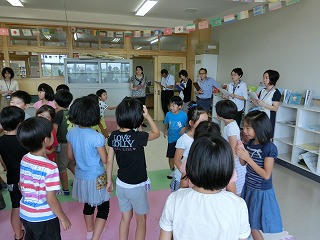 This was a good warm-up to get students ready to study English.
This was a good warm-up to get students ready to study English.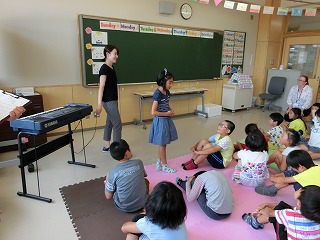 "If you do all three things, they will feel very happy!"
"If you do all three things, they will feel very happy!"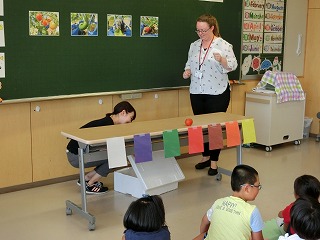 The students said a vegetable that they gew in Japanese. Then, Ms. Ayaka took it out of the box and Ms. Emily taught everyone the English word.
The students said a vegetable that they gew in Japanese. Then, Ms. Ayaka took it out of the box and Ms. Emily taught everyone the English word.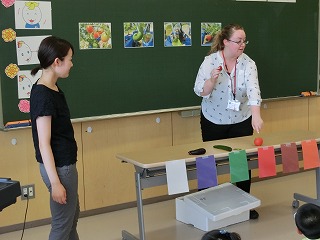 Ms. Emily couldn't see the color cards from behind the desk so she asked the students, "Here? Is this red?"
Ms. Emily couldn't see the color cards from behind the desk so she asked the students, "Here? Is this red?"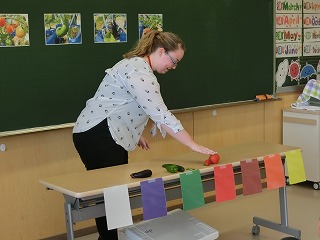 It meant everyone got a lot of practice saying the new words.
It meant everyone got a lot of practice saying the new words.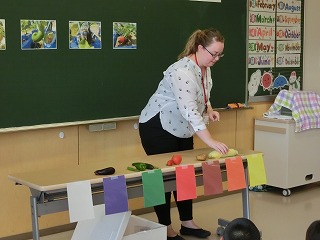 "No!! That's orange!!"
"No!! That's orange!!"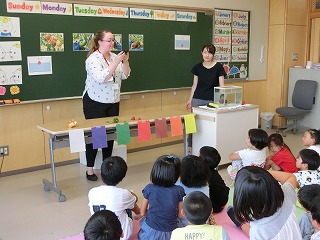 The students would correct her.
The students would correct her.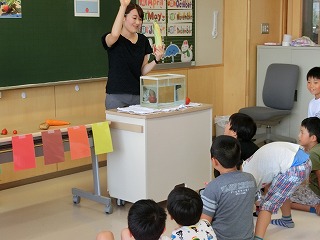 "Will corn float?"
"Will corn float?"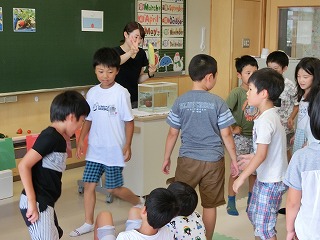 "Sink or float? 5, 4, 3, 2, 1, sit down!"
"Sink or float? 5, 4, 3, 2, 1, sit down!"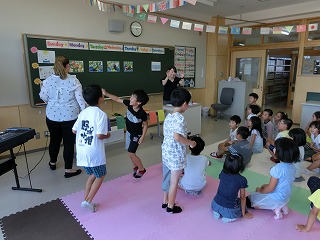 "Yeay!!!"
"Yeay!!!"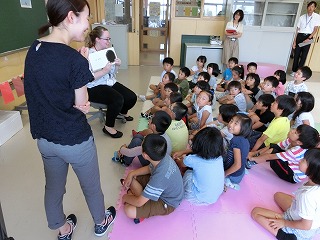 "Hmmm....sweet potato?"
"Hmmm....sweet potato?"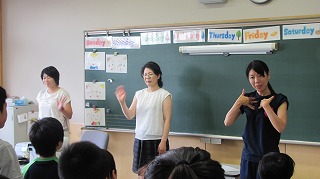 "Hello everyone!"
"Hello everyone!"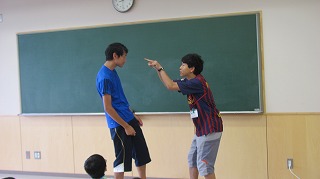 Mr. Kakinuma and Mr. Suda are demonstrating how to make good eye contact.
Mr. Kakinuma and Mr. Suda are demonstrating how to make good eye contact.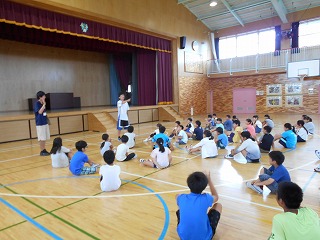 "Who can tell me the good points?"
"Who can tell me the good points?"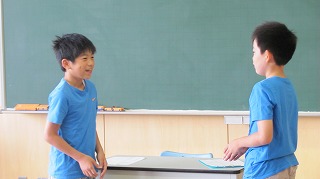 Here some 5th grade students are showing the 1st graders a good example of greeting each other. Nice smile!
Here some 5th grade students are showing the 1st graders a good example of greeting each other. Nice smile!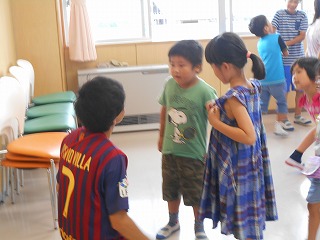 By taking part in the activities they provide a good example to the students.
By taking part in the activities they provide a good example to the students.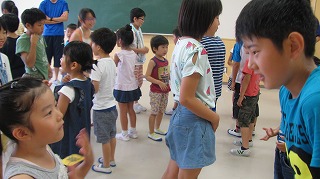 As well as taking part in the activities the teachers watch the students in order to praise students after the activity has finished. What do you think the teachers would praise about this pair?
As well as taking part in the activities the teachers watch the students in order to praise students after the activity has finished. What do you think the teachers would praise about this pair?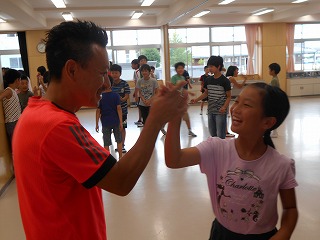 Mr. Ota tries very hard to speak English so let's all try hard, too!
Mr. Ota tries very hard to speak English so let's all try hard, too!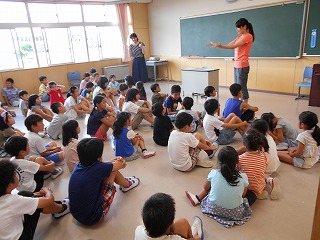 They also ask students questions.
They also ask students questions.